Introduction
Few animals are more iconic than the black-and-white striped plains zebra (Equus quagga), also known as Burchell’s zebra. When you think of the African savannah, the zebra is probably one of the first animals to spring to mind. But zebras are in danger of extinction and there are only 500,000 left in the wild.1https://www.iucnredlist.org/species/41013/45172424#population This might seem like a lot but it’s not when you consider the immense size of Africa, and the fact that their population has decreased by a quarter since 2002.1https://www.iucnredlist.org/species/41013/45172424#population
Uganda may be home to around 3,000 zebras,2https://chimpreports.com/learning-about-ugandas-glorious-zebras/ although the International Union for Conservation of Nature’s Red List of Threatened Species’ estimate is much much lower, at between 425 and 636.1https://www.iucnredlist.org/species/41013/45172424#population They can be found across the country’s grasslands and savannahs, with the largest herds in Kidepo Valley and Lake Mburo national parks.3https://ugandawildlife.org/animals/zebra/ The plains zebra stands at about 4.5 feet (1.4 m) with a head-body length of about 7.5 feet (2.3 m). Males weigh about 35 to 50 stone (220–322 kg) while females weigh 27 to 39 stone (175–250 kg). Plains zebras are intermediate in size between the larger Grévy’s zebra and the smaller mountain zebra – all native to Africa.
Fascinating facts
One’s true stripes

Each individual zebra has unique stripes, like the spots of a leopard or the fingerprint of a human. While the stripes look purely black and white at a glance, they often also have tones of brown. Baby zebras – or foals – are born with shaggier hair and brown stripes so they blend in with their background and are harder for predators to spot.
Blending in with the crowd

You might think that a zebra’s bold stripes make them stand out on the green-brown savannah but they actually help to camouflage them from lions. Zebras aren’t trying to blend in with the grass, but blend in with each other so it is much harder for a predator to pick out a single zebra from the herd. You might wonder if a zebra is black with white stripes or white with black stripes. Most agree that they’re actually black with white stripes – if you were to shave a zebra (but why would you?!), it would be all black.4https://www.britannica.com/story/are-zebras-white-with-black-stripes-or-black-with-white-stripes
Zorse, hebra and zedonk

Zebras are closely related to horses but are a different species. Zebras and horses are so closely related that they can even breed with each other. When a male zebra mates with a female horse the foal is called a zorse, and a female zebra and male horse produce a hebra. Zebras can also breed with donkeys, to produce a zedonk!5https://www.discoverwildlife.com/animal-facts/mammals/facts-about-zebras
Zuper zebras
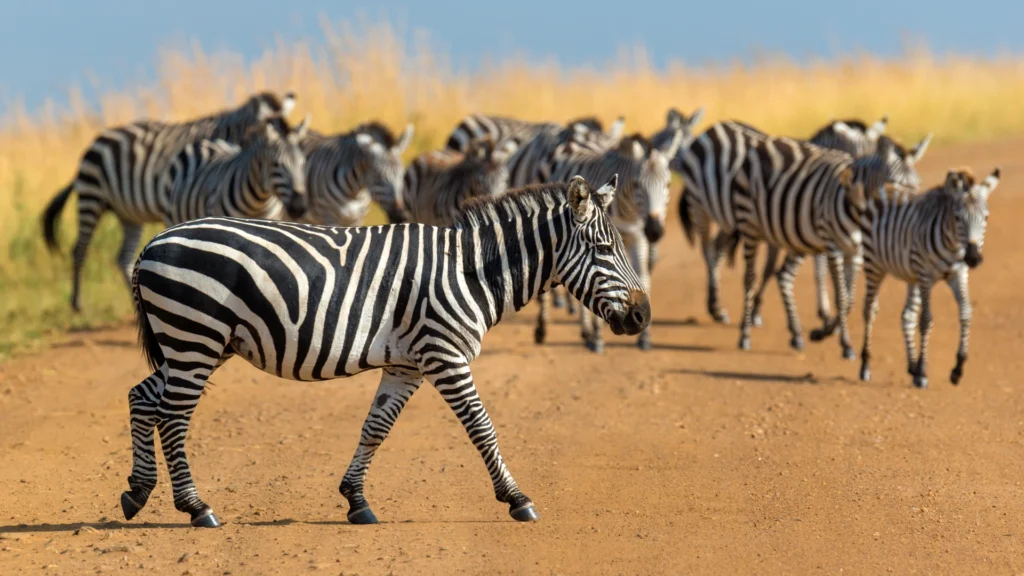
Zebras usually live in family groups (called harems) of one male (stallion), several females (mares) and their young, but these groups join together to form a “super herd” of up to 300 individuals. Zebras know that the larger the group, the less chance they have of getting picked out by a predator. This has proven to be a successful strategy as, despite being on many a predators menu (including lions and hyenas), most zebras live between 15 and 20 years in the wild.6https://www.animalfactsencyclopedia.com/Zebra-facts.html
Zebras are very effective communicators
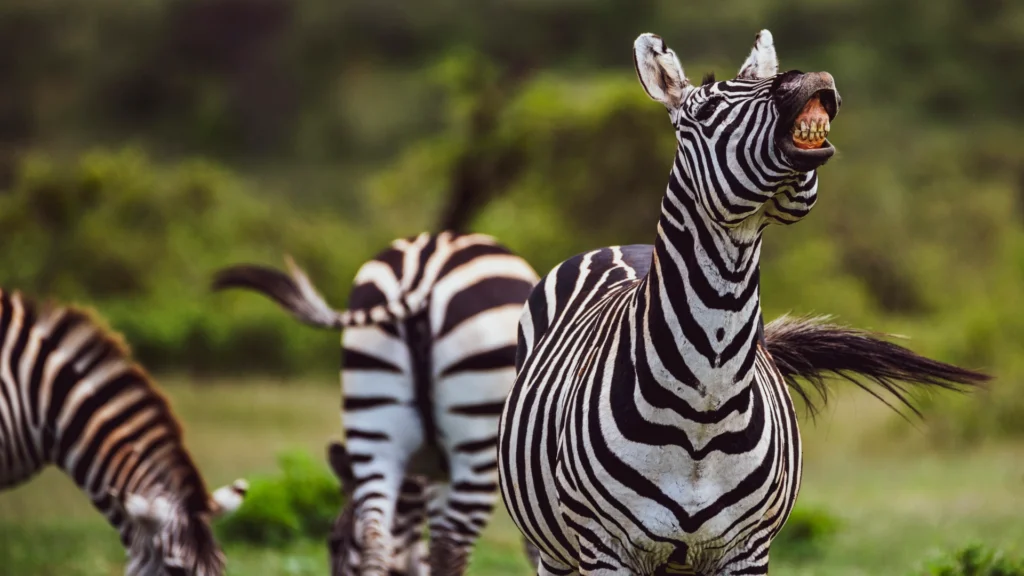
Zebras have different calls and facial expressions to alert others to the presence of a predator, indicate distress and to get another zebra’s attention. A two-syllable call is used to warn the herd of predators and snorts show happiness.7https://www.awf.org/wildlife-conservation/zebra Male zebras will say hello with their ears up but then flatten them back to indicate a threat. Zebra’s can even remember and recognise each other from their individual stripes!8https://destinationuganda.com/animals/burchells-zebra/
I’ll groom your back if you groom mine.
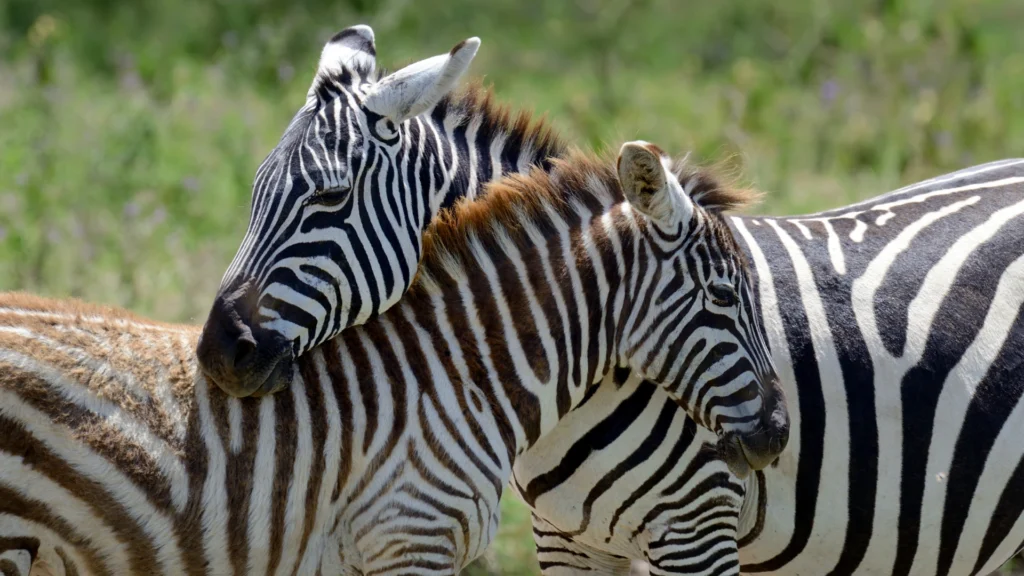
Zebras bond and form friendship through grooming each other. Two zebras will stand side-by-side, head-to-tail, and groom each other with their teeth and lips. Not only does this strengthen family ties but they also keep each clean by removing parasites. A strong family bond comes in handy when a zebra is attacked by a predator such as lion or hyena. If this happens, the zebra’s whole family will circle around the wounded zebra and try to protect it from and drive off the attacker.9https://www.nationalgeographic.com/animals/mammals/facts/plains-zebra
On your feet!

Female zebras will only mate with the dominant stallion of their harem. Pregnant mares carry the baby for about a year before giving birth to a foal. Just 20 minutes after being born the foal is able to walk and an hour later it can even run with the herd! A mother zebra will keep a close eye on her foal, making she they are safe and also imprinting their own stripe patterns, scent and vocalisation on the foal so they can always be recognised.10https://www.pbs.org/wnet/nature/blog/zebra-fact-sheet/
Any old grass
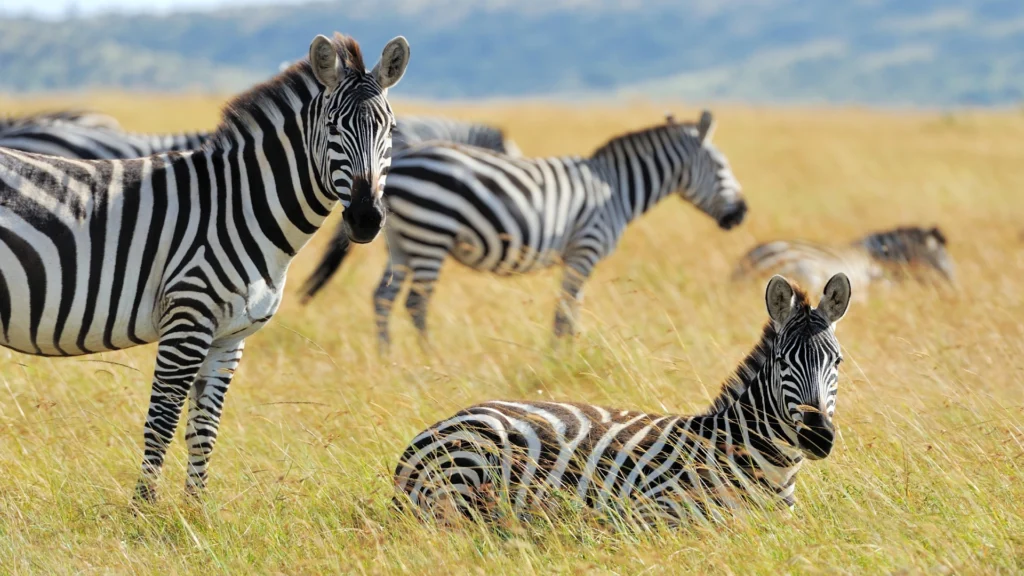
Unlike many other hooved animals in Africa, zebras don’t need short grass to graze. They eat a wide number of different grasses and sometimes leaves and saplings. This ,means they can roam more widely. They are known as ‘pioneer grazers’ and prepare the plains for more specialised grazers who need shorter grass.7https://www.awf.org/wildlife-conservation/zebra
Threats to plains zebras
Habitat loss
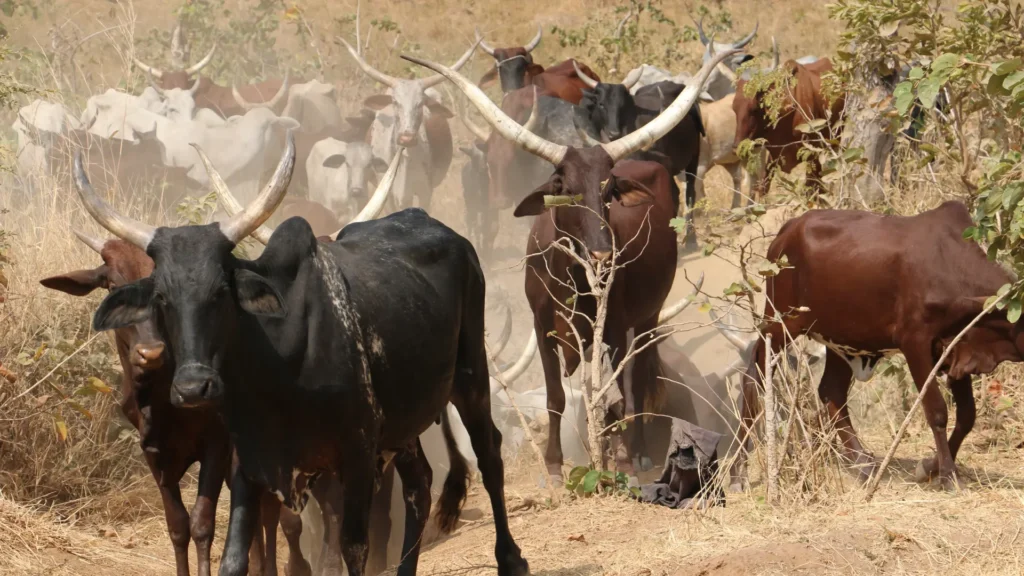
The plains zebra is a near-threatened animal and its numbers are steadily decreasing. This is mainly caused by habitat loss as the human population of Uganda increases and spills into the natural habitat of zebras. As the human population grows, more land is converted into settlements and farmland, and fragmented by roads. Bit by bit, the zebra’s beautiful natural habitat is shrinking and being destroyed by the expansion of human infrastructure.
Fifty years ago, Uganda’s zebras could freely roam across the country but today they have become isolated in parks and reserves, cut off from each other by human developments.
Competition with livestock is a major factor in the decline of zebras.7https://www.awf.org/wildlife-conservation/zebra Uganda’s savannahs have been in a delicate balance for millennia but humans are upsetting this equilibrium with the introduction of livestock, in particular cows farmed for dairy and beef. Zebras and cows are both grazing animals and depend on the same food source. Fenced-off cattle ranches mean that the zebra can no longer reach the food they would have once depended on, and even when cattle are not segregated from zebras, they are over-grazing the land, leaving nothing left for zebras to eat. Fewer essential resources simply means fewer zebras can survive. This was proved by an experiment in Kenya that revealed that when cattle were removed from certain areas, the zebra population increased by 46 per cent.11https://www.sciencedirect.com/science/article/abs/pii/S0006320704003799 In short, more cattle equals fewer zebras.
On the other hand, crops are a far more efficient way to feed the growing population and use less land and other natural resources than animal agriculture. A vegan diet is associated with only half the cropland demand, grazing intensity and overall biomass harvest of meat-based diets12https://www.nature.com/articles/ncomms11382 so switching to a vegan diet would have a phenomenal impact on reducing habitat destruction in Uganda.
Climate change & desertification

Zebras are particularly vulnerable to climate change and habitat degradation. Zebras can only survive on grasslands and savannahs and are unable to survive in forests and deserts. Unfortunately, Uganda is one of many countries threatened by desertification.13https://www.newvision.co.ug/news/1521179/uganda-building-resilience-drought-desertification Desertification happens when land is overexploited, dry and no longer fertile, becoming desert. In Uganda the main drivers of desertification include drought, deforestation, bush burning, and poor farming methods. Of the latter, the overgrazing of cattle is a huge problem.
Desertification isn’t just a problem for the wildlife of Uganda, it’s a problem for the people too. As Ugandan journalist, Jacqueline Nalukwago says: “continued land degradation therefore impends Uganda’s development efforts through low-yield crops which garners poverty since affected person resort to negative coping strategies like selling livestock and keeping children out of school.”13https://www.newvision.co.ug/news/1521179/uganda-building-resilience-drought-desertification We can probably also add poaching and exploitation of natural resources to that list of negative coping strategies. So, it’s not only vital for the wildlife of Uganda that more sustainable farming methods are found, but it’s vital for the local people too.
Hunting
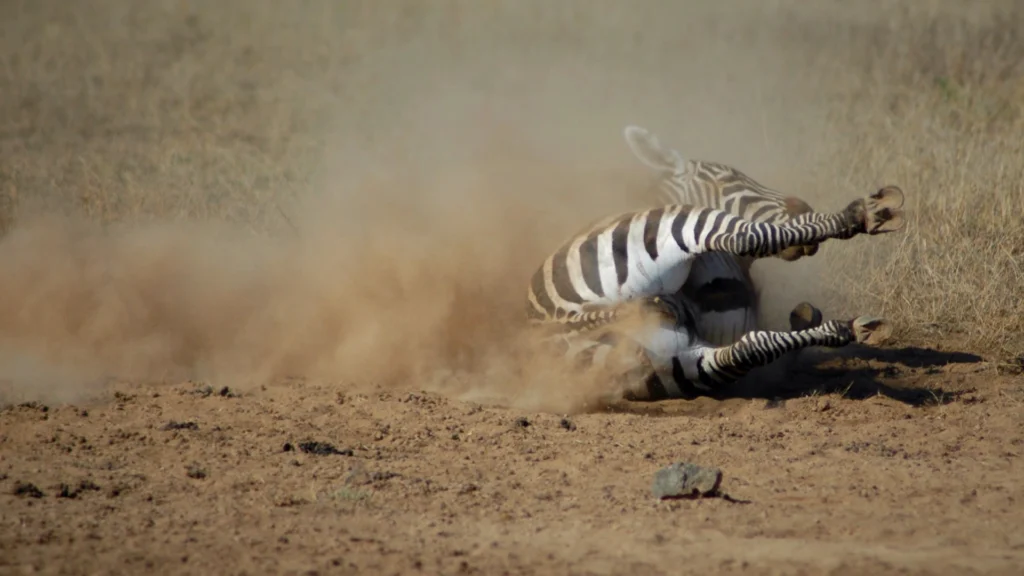
The plains zebra is the most commonly hunted zebra species, and hunting poses a serious danger to all zebra populations.7https://www.awf.org/wildlife-conservation/zebra In fact, a 2015 scientific review named hunting as the top threat to terrestrial herbivores, including the zebra.14https://www.science.org/doi/10.1126/sciadv.1400103
Zebras are hunted for their skins and their flesh. Between 2001 and 2016, 272 zebras were hunted and killed just around Lake Mburo, making it the second most hunted animal after the impala.15https://www.jstor.org/stable/26937301
Zebras are also hunted for sport – usually by tourists – and by local people for meat. Sport – or trophy – hunting was banned in Uganda in 1979 only to be allowed again in 2001. It was believed that by making the wildlife of Uganda more profitable, negative attitudes towards wild animals would improve. There is no evidence of this. It is also often argued that the money from ‘sport’ hunting aids conservation efforts, however, researchers in Uganda found no evidence of this either.15https://www.jstor.org/stable/26937301
Local people hunt zebras for subsistence (to feed themselves and their family) and to sell the flesh as bushmeat. Subsistence hunting increases when crops fail, and in times of poverty as local people cannot afford to buy other foods. Selling bushmeat to wealthier city-dwellers also provides a source of income. However, bushmeat hunting is unsustainable and “a major threat to wildlife and its consumption is associated with an increased risk of acquiring zoonotic diseases”16https://www.ncbi.nlm.nih.gov/pmc/articles/PMC5362244/ – that is diseases which can be passed from animal to human, like ebola.
A more stable economy, better education that includes an appreciation for Uganda’s wildlife, and the development of more sustainable farming practices, that do not worsen the environmental and economic situation, are needed to save the zebra and conserve Uganda’s iconic ecosystems.
References
References
- 1
- 2
- 3
- 4
- 5
- 6
- 7
- 8
- 9
- 10
- 11
- 12
- 13
- 14
- 15
- 16

